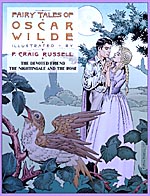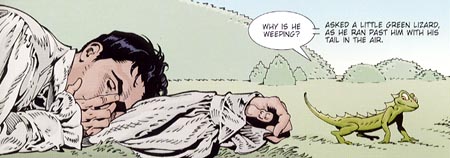 By P. Craig Russell
By P. Craig Russell
Based on short stories by Oscar Wilde
32 pages, color
Published by NBM
It’s been a little over six years since the last volume of P. Craig Russell’s Fairy Tales of Oscar Wilde, and I hadn’t realized how much I missed them. As I read the two stories Russell adapted here, it was nice to see that over 110 years after Wilde originally wrote these pieces, they’re just as relevant and pleasant to read now as they must have been then.
The first story, “The Devoted Friend”, is a fable about what is the real meaning of friendship. Told in a framing device as a lesson from one animal to another, Russell does a good job of keeping both the main story-within-a-story as well as the outside narrative separate, and in making sure that Wilde’s story still retains its satirical edge. The story is told with such earnestness that, by keeping a straight face, it never comes across as preachy or over-the-top. Hugh the Miller isn’t your typical villain, as Russell keeps his behavior restrained to the point that you could make a good arguement for if Hugh does or does not truly understand how little of a “devoted friend” he truly is.
The art of “The Devoted Friend” is light and iconic, with Hugh and Hans’s simple faces, or the stylized animals cavorting in the water. It’s an important atmosphere for the story, as the breezy and carefree art helps lull the reader into a false sense of security as Hugh abuses his so-called friendship more and more with each passing page. By the time things get truly bad for Hans, it’s snuck up on the reader and hopefully catches one unaware. With so many panels carefully fit onto each page, Russell’s able to move the story along quickly and succinctly, adding in a lot of material in such a short amount of space.

Very different in style is the second half of the book, “The Nightingale and the Rose”. When a nightingale hears of a student’s plight on how he can never win the heart of his one true love without a red rose, the nightingale goes to an extraordinary measure to get the student what he needs. This is a much darker and somber story than the first, almost a treatise on what people will do for love. Wilde’s story says a lot about how people often do not truly appreciate or understand what others have done for them, and it comes through very strongly in this adaptation. Those who have perhaps only read the lighter stories by Wilde will quickly discover that “The Devoted Friend” wasn’t the only fairy tale of his with a darker ending. This one delivers a strong one-two punch as it comes to its conclusion, though, both for the student’s ultimate reaction to the nightingale’s gift, and then the professor’s daughter’s reaction to the gift of the student. After letting the story linger over its earlier elements, Russell delivers the conclusion in a quick manner that really lets the events almost run into each other, letting the reader really get the full effect of Wilde’s story of love.
With a darker and more somber story to illustrate, Russell’s art style here is much more serious as well. The human figures here are drawn in more of an art deco manner, with lush outfits and stylings to provide a real richness to the page. His characters move across the page here almost like opera singers, with stylized poses and expressions to bring across the drama and heartbreak that exist in “The Nightingale and the Rose”. Special attention also has to be brought, though, to Lovern Kindzierski’s colors that really accentuate the page. The deep colors of night and the blackness of the thorns that surround the nightingale are outstanding, really helping set the mood for us as readers to get the full effect of Wilde’s story as well as Russell’s art. Every page of art here is ultimately nothing short of exquisite.
While the two stories in this volume of Fairy Tales of Oscar Wilde are distinctly different in tone from each other, there is a common theme of sacrifice and the price that people pay in order to help others. It’s a strong pairing—this is easily the best volume of Russell’s Fairy Tales of Oscar Wilde to date. Russell truly is an “artist’s artist”; it’s easy to see why people who create art hold his work in such regard. It’s sad to think that there are only two more stories left for Fairy Tales of Oscar Wilde to adapt, but these books are strong enough that reading them over and over again will never truly get old. Timeless stories adapted by a timeless artist—what more can you ask for?
Purchase Links:
